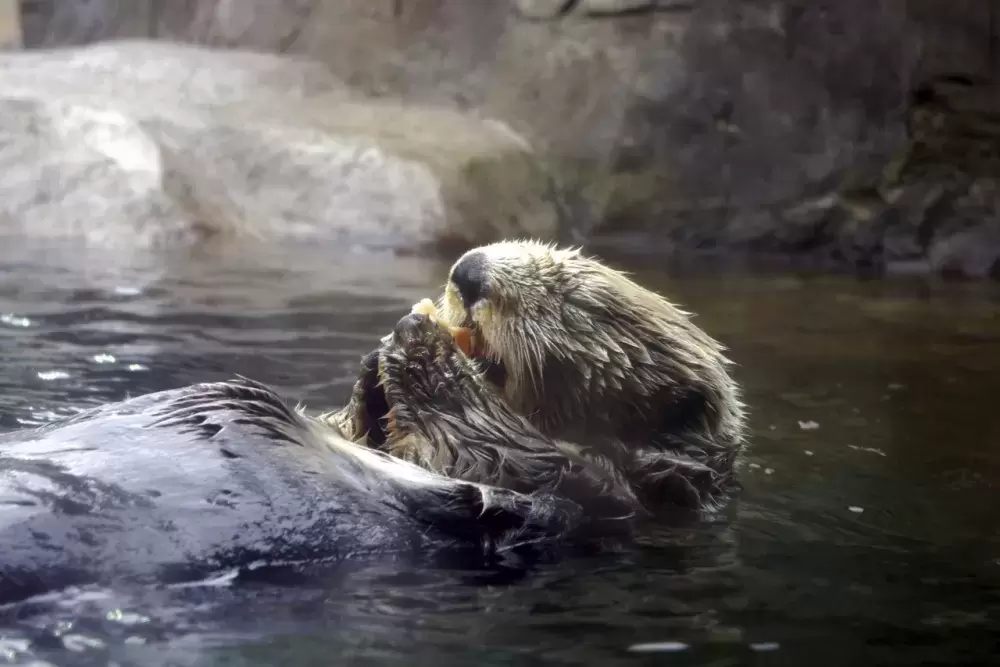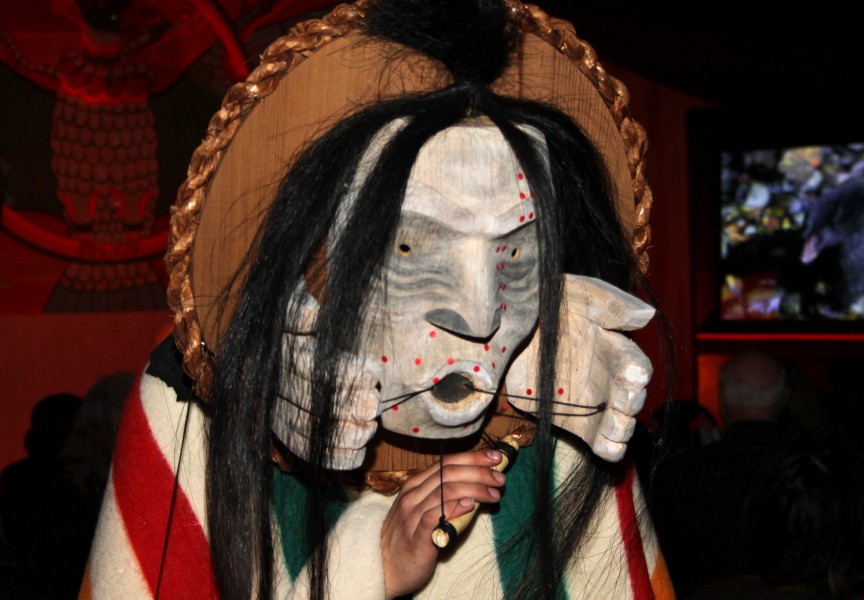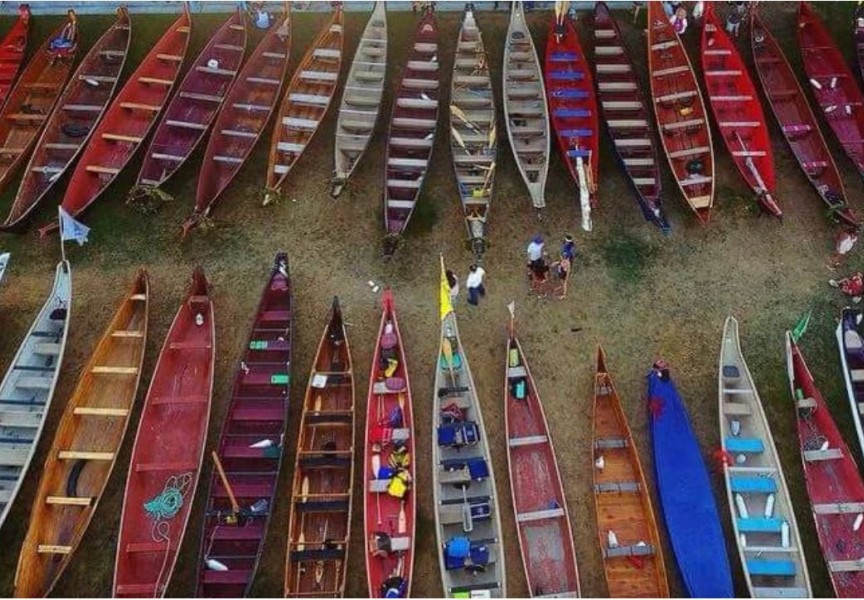Near Ahousaht’s coast lies Sea Otter Rock, a fixation in the First Nation’s territory that serves as a reminder for the active mammal not to overreach its place in the surrounding ecosystem. Oral history recounts a time when the other animals gathered to discuss the sea otter’s gluttony after it became clear it was taking food from other creatures.
“The sea otter was getting too greedy,” recounted Kiista, Keith Atleo, during a Council of Ha’wiih Forum on Fisheries in February.
The animals took the problem to a chief, who then told the thunderbird what was happening. The thunderbird warned the sea otter to stop taking food from the other animals, but when the head otter refused to follow this directive, it was turned into a rock as a warning to the others.
Observations along the central and northwest coast of Vancouver Island indicate that such an intervention might be necessary again. After the animals reached extinction in the region a century ago, the introduction of 89 otters from Alaska between 1969 and 1972 has grown to over 4,000, a population surge that has affected other species.
Saqᵂistl, Hilda Hanson, is an elder with the Kyuquot/Cheklesaht Nation. Over her lifetime she’s seen a supply of shellfish that the Kyuquot community once fed upon disappear due to the resurgence of sea otters.
“We had big clam beaches in Kyuquot. Actis, it was the best clam beach that ever was. All kinds, big clams, little clams,” she said, adding that people could once go down to the beach with a can to dig up whatever they wanted. “No more. No more clams. That’s when k̕wak̕aƛ [sea otter] came around, ate up all the clams. We had to go somewhere else.”
“We can’t afford to keep feeding them, they eat too much. They don’t need low tide to access resources, they can dive,” said Archie Little, an elected councillor with the Nuchatlaht First Nation. “We’re going to run out of food before we collect all the data.”
In Tla-o-qui-aht territory, the community has seen otters rid the area of sea urchins, or t’ucup in Nuu-chah-nulth.
“In our area we don’t have any more t’ucup, we don’t have any more to bring to our people,” said Chief Councillor Elmer Frank. “I know last year a couple of our members had to go to the east coast of the island to provide some for our elders. We do know the effects sea otters are having in our beds that provide rich seafood for our people.”
Further down the coast, Hup-in-Yook (Tom Happynook), the Huu-ay-aht’s traditional whaling chief, hasn’t seen sea otters return to his First Nation’s territory yet. But the situation in Kyuquot is worrisome.
“We are concerned; we’re waiting for them to arrive,” he said.
These comments have helped to inform Coastal Voices, an ongoing research project investigating the social and ecological changes triggered by the recovery of sea otters on the West Coast, from Alaska to Vancouver Island. The project is guided by a steering committee of Nuu-chah-nulth, Heiltsuk, Haida and Sugpiaq hereditary chiefs and knowledge holders, working with the nations and researchers from Simon Fraser University. Using traditional knowledge and Western science, the goal of Coastal Voices is to collect information that brings respectful dialogue to help communities deal with the return of sea otters. Since it launched in 2013, the project has been funded by Pew Charitable Trusts, a non-government organization that finances research around the world.
“We travelled to communities that have been experiencing different stages of sea otter recovery,” said Anne Salomon, an associate professor at SFU, during her presentation of the project’s progress to Nuu-chah-nulth delegates at the Council of Ha’wiih fisheries meeting. “We actually interviewed people and asked them a variety of questions about how people managed sea otters in the past, in deep time, what kind of protocols were used for that management.”
As a keystone species on the West Coast, the sea otter has proven to significantly affect the coastal territories where it lives. With a metabolic rate two to three times faster than land mammals of a similar size, the sea otter is a voracious hunter, consuming up to 30 per cent of its body weight in a day. For an adult male that could be a daily diet of nearly 15 kilograms of food, an appetite that benefits from the animal’s ability to dive 30 metres deep, with dexterity capable of using rocks as tools to break open shellfish.
The otter’s effect on the surrounding ecosystem is evident through the rapid decline of their preferred prey, including sea urchins (t’ucup), crabs, clams, mussels and other shellfish. Jenn Bert, an SFU marine ecologist leading the research project, recalled seeing an area on the coast of Vancouver Island transform in one year due to otters.
“It took less than a year to go from high amounts of t’ucup to low amounts of t’ucup. They’re very fast and efficient eaters,” she said, noting that the decline of urchins has allowed kelp forests to expand. “In 2013 when we swam underwater we saw very large sea urchins, probably some the size of my head. And then in 2014 when we returned it looked like a little growing forest of lots of kelp.”
“When otters get to an area, they tend to focus on the biggest bang for their caloric buck: urchins,” said Salomon, adding that the animal’s diet becomes more diverse after living in an area for a number of years. “Those sites where otters have been around for at least 33 years had 16 times less in the number of abalone than those where otters have not been around since about the 1850s.”
“Today, when you look at the shoreline, in places where there aren’t otters, you tend to see lots of big California mussels,” continued Salomon. “And if you go to places where otters have lived for a long time, like Kyuquot/ Cheklesaht, you tend to see very, very small mussels.”
Oral history and archeological findings show that sea otters existed throughout Nuu-chah-nulth territory for thousands of years. Remains discovered in the refuse heaps of ancient village sites indicate the importance of sea otters to the everyday life of Nuu-chah-nulth-aht.
“If you look at those shell middens and you count the relative number of otter bones, you can see that in some places a lot of otters were landed, they were hunted and in high amounts,” said Salomon.
Sea otters have the thickest fur of any sea mammal, protecting the skin from even getting wet if an animal is healthy. This brought a connotation of high status, and when visitors came into a Nuu-chah-nulth nation’s territory, they were often greeted by the ha’wilth wearing otter fur, signifying the richness of a community.
“Sea otter fur was used as clothing and adornment, with only the highest-ranking people and ha’wiih wearing these fantastic garments,” stated a research document from Uu-a-thluk, the NTC’s fisheries department. “Sea otter hunting required strict adherence to protocol. Only certain Nuu-chah-nulth-aht had the privilege to hunt sea otters, and as with other types of hunting, they undertook serious physical, mental and spiritual preparation referred to as ?uusimch.”
Otter fur became a sought after commodity after Captain James Cook first landed in Yuquot in 1778. Trade with Europeans and Russians quickly intensified, and overhunting eventually led to extirpation by the early 20th century on Vancouver Island’s west coast.
Downgraded from “endangered” to “threatened” to the current listing as a “species of special concern” under Canada’s Species at Risk Act, otter management plans currently prohibit hunting practices the Nuu-chah-nulth once employed to control the population of the species. But across the border in Alaska, where the otter population is estimated at over 79,600, the situation is quite different. There a provision in the US Marine Mammal Protection Act allows Alaska’s Indigenous Peoples to hunt otters for subsistence, traditional handicrafts and clothing.
Burt observed that many Indigenous people in the northern state felt that hunting allowed them to keep their ancient traditions alive.
“In Alaska the federal regulations were very helpful for people to coexist with sea otters,” she said. “They felt that was actually very important.”
“I’d like to see that we reclaim our deep time laws and make them live again. Those laws, as you know, as based on respect and balance,” said Kii-iljuus (Barbara Wilson), a Haida cultural advisor on the Coastal Voices research team. “I think that this is an opportunity to empower our old laws and use them in decision making. We know that our ancestors had thousands of years of working on the land, working on the ocean and working in various things in managing them, whether it was to increase numbers or hold them back.”
The inability to legally exercise population control through hunting was a foremost frustration for Kyuquot residents struggling with living alongside the energetic sea hunters, recounted Burt.
“Having a sea otter management plan was something that people identified as something that would help their community to adapt to sea otters,” she said. “Having Indigenous authority and decision making is something that would improve people’s ability to coexist with sea otters.”
In February Coastal Voices was granted permission from Nuu-chah-nulth ha’wiih to continue researching how to maintain productive shellfisheries with a viable sea otter population. Over the coming years the need to identify ecologically sustainable and socially just hunting practices is destined to become a focus for the project. For some in communities that have been on the coast for hundreds of generations, part of the solution includes lies in reintroducing simple practices.
“Traditionally we had people who were responsible for taking care of the resources, and when the sea otter was abundant in our territory, this family would be charged with protecting our clam beaches, our crab harvesting areas,” recalled Happynook. “My grandfather used to say that to deter the sea otters from coming onto the beach, they would kill a couple of them and anchor them out in front of the beach so that the sea otters that were coming in would see their cousins had been killed. We used that as a deterrent.”







